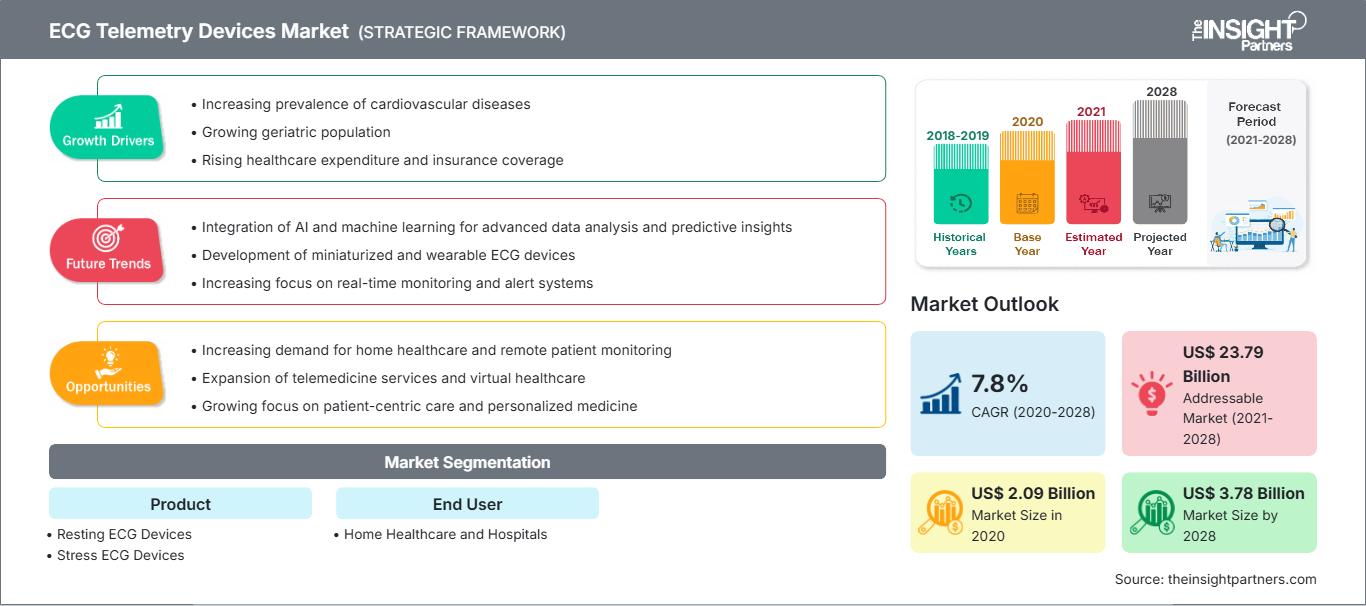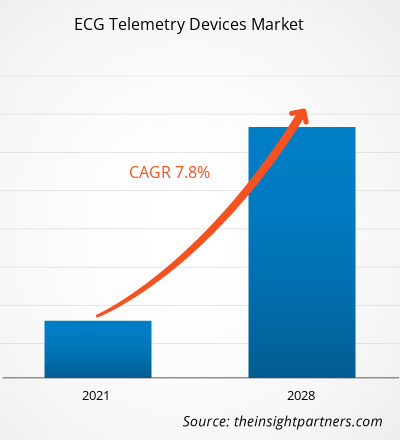The ECG telemetry devices market is expected to reach US$ 3,783.48 million by 2028 from US$ 2,087.66 million in 2020 ; it is estimated to grow at a CAGR of 7.8% during 2021–2028.
ECG device monitors and records electrical activity of the heart. ECG picks up electrical impulses generated by the polarization and depolarization of cardiac tissue and translate them into a wave form. This helps physician or cardiologist to diagnose cardiac abnormalities and measure the size and position of chambers. The growth of the ECG telemetry devices market is attributed to the factors such as increase in cardiovascular disease incidence and surge in geriatric population. However, the high cost and disadvantages of ECG telemetry devices restrain the market growth.
Customize This Report To Suit Your Requirement
You will get customization on any report - free of charge - including parts of this report, or country-level analysis, Excel Data pack, as well as avail great offers and discounts for start-ups & universities
ECG Telemetry Devices Market: Strategic Insights

-
Get Top Key Market Trends of this report.This FREE sample will include data analysis, ranging from market trends to estimates and forecasts.
Market Insights
Increase in Cardiovascular Disease Incidence
The world has been witnessing notable developments in mobile health (mHealth) from the last decade, which is offering physicians and patients new approaches to manage many diseases, including atrial arrhythmias, ventricular arrhythmias, ventricular, atrial fibrillation. The growing prevalence of arrhythmia and other cardiovascular diseases (CVDs) is triggering the need for improved diagnostic methods. ECG telemetry systems are the most effective instruments used for detecting arrhythmias. These devices allow simpler and quicker heart monitoring, which has added to their popularity. According to the World Health Organization (WHO), CVDs are the leading cause of death worldwide, with ~30 million people experiencing a stroke each year. According to the American Heart Association, almost half of all adults in the US have a kind of CVD. More than 130 million people, i.e., 45.1%, of the US population are projected to have a type of CVD by 2035. Furthermore, the European Society of Cardiology reported that Atrial fibrillation is the most common arrhythmia, and it accounts for 0.28–2.6% of healthcare spending in European countries. It also mentioned that patients suffering from atrial fibrillation at a five-times greater risk of getting a stroke, and 20–30% of total stroke cases in Europe are caused due to atrial fibrillation. As per the study conducted by the European Society of Cardiology in 2016, in the EU, ~7.6 million people with age 65 years and above had atrial fibrillation. As per the European Society of Cardiology estimates, the number is expected to increase by 89% to reach ~14.4 million by 2060. The prevalence of atrial fibrillation is estimated to reach 9.5% by 2060 from 7.8% in 2016. Further, as per the report “Beyond the Burden: The Impact of Atrial Fibrillation in Asia Pacific” by Biosense Webster, published in 2019, more than 16 million people in Asia Pacific suffer from atrial fibrillation , and the number is expected to reach ~72 million by 2050. The report also suggests that the condition has affected the middle-aged and elderly population more.
A few of the primary risk factors for CVDs are family history, ethnicity, and age; other risk factors include tobacco consumption, hypertension, obesity, high cholesterol, physical inactivity, diabetes, unhealthy diets, and alcohol consumption. Further, lifestyle changes are leading to the rise in the incidence of diseases such as diabetes, hypertension, dyslipidemia, and obesity, contributing to a surge in CVD cases across the world. Most types of CVDs can be prevented through pre-monitoring and pre-diagnosis. Likewise, abnormalities in the functioning of the heart, arrhythmias, can be averted with early diagnosis. Owing to this, the demand for ECG telemetry devices is increasing as these devices help save patients at high risk of cardiac arrest.
Product-Based Insights
The ECG telemetry devices market, by product, is segmented into resting ECG devices, stress ECG devices, and others. The resting ECG devices segment held the largest share of the market in 2020. Also, the same segment is anticipated to register the highest CAGR in the market during the forecast period.
End User-based Insights
Based on end user, the ECG telemetry devices market is bifurcated into home healthcare and hospitals. The hospitals segment held a larger share of the market in 2020, and the same segment is anticipated to register a higher CAGR in the market during the forecast period.
Product launches and approvals are the commonly adopted strategies by companies to expand their global footprints and product portfolios. Moreover, the ECG telemetry devices market players focus on the collaboration strategy to enlarge their clientele, which, in turn, permits them to maintain their brand name globally.
ECG Telemetry Devices Market Regional InsightsThe regional trends and factors influencing the ECG Telemetry Devices Market throughout the forecast period have been thoroughly explained by the analysts at The Insight Partners. This section also discusses ECG Telemetry Devices Market segments and geography across North America, Europe, Asia Pacific, Middle East and Africa, and South and Central America.
ECG Telemetry Devices Market Report Scope
| Report Attribute | Details |
|---|---|
| Market size in 2020 | US$ 2.09 Billion |
| Market Size by 2028 | US$ 3.78 Billion |
| Global CAGR (2020 - 2028) | 7.8% |
| Historical Data | 2018-2019 |
| Forecast period | 2021-2028 |
| Segments Covered |
By Product
|
| Regions and Countries Covered |
North America
|
| Market leaders and key company profiles |
|
ECG Telemetry Devices Market Players Density: Understanding Its Impact on Business Dynamics
The ECG Telemetry Devices Market is growing rapidly, driven by increasing end-user demand due to factors such as evolving consumer preferences, technological advancements, and greater awareness of the product's benefits. As demand rises, businesses are expanding their offerings, innovating to meet consumer needs, and capitalizing on emerging trends, which further fuels market growth.

- Get the ECG Telemetry Devices Market top key players overview
ByProduct
- Resting ECG Devices
- Stress ECG Devices
- Others
By End User
- Home Healthcare
- Hospitals
By Geography
-
North America
- US
- Canada
- Mexico
-
Europe
- France
- Germany
- Italy
- UK
- Spain
- Rest of Europe
-
Asia Pacific (APAC)
- China
- India
- South Korea
- Japan
- Australia
- Rest of Asia Pacific
-
Middle East and Africa (MEA)
- South Africa
- Saudi Arabia
- UAE
- Rest of Middle East and Africa
-
South and Central America (SCAM)
- Brazil
- Argentina
- Rest of South and Central America
Company Profiles
- Cardiac Science Corporation
- CompuMed Inc.
- GE Healthcare Inc.
- Medtronic Inc.
- Mindray Medical International Ltd.
- Nihon Kohden Corporation
- Philips Healthcare
- ScottCare Corporation
- Dragger
- Welch Allyn Inc.
Frequently Asked Questions
Who are the major players in the ECG Telemetry Devices market?
What are the driving factors for the ECG Telemetry Devices market across the globe?
What are ECG Telemetry Devices?
- Historical Analysis (2 Years), Base Year, Forecast (7 Years) with CAGR
- PEST and SWOT Analysis
- Market Size Value / Volume - Global, Regional, Country
- Industry and Competitive Landscape
- Excel Dataset
Recent Reports
Testimonials
Reason to Buy
- Informed Decision-Making
- Understanding Market Dynamics
- Competitive Analysis
- Identifying Emerging Markets
- Customer Insights
- Market Forecasts
- Risk Mitigation
- Boosting Operational Efficiency
- Strategic Planning
- Investment Justification
- Tracking Industry Innovations
- Aligning with Regulatory Trends





















 Get Free Sample For
Get Free Sample For